You’re probably tired of manually adjusting your blinds throughout the day, especially when you’re comfortable on the couch or your hands are full. Smart blinds that work with Alexa can transform how you control natural light in your home, but not all motorized options play nicely with Amazon’s voice assistant. The key lies in understanding compatibility requirements, choosing the right brands, and knowing which features will actually make your daily routine easier.
What Makes Blinds Compatible With Alexa
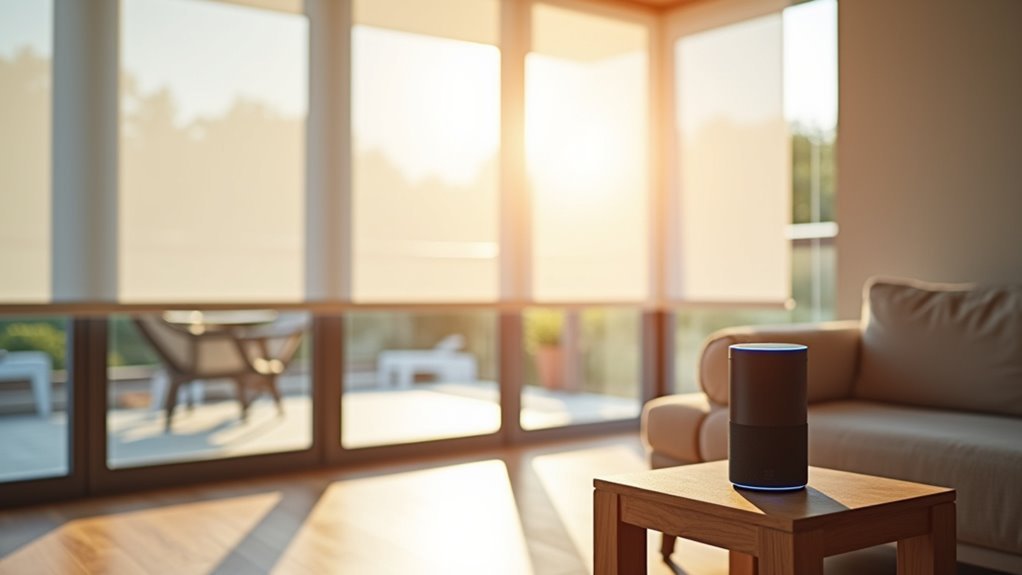
When you’re shopping for Alexa-compatible blinds, the key requirement is that they connect to a smart hub supporting voice integration, such as the Lutron Caséta Smart Hub or any Matter-compatible device.
Smart blinds requiring hub connectivity with voice integration capabilities ensure seamless Alexa compatibility for automated home control.
Your smart blinds must be motorized and capable of internet connectivity to pair with Amazon Alexa effectively.
Once connected, you’ll gain remote control capabilities and scheduling features through voice commands. You can create customizable phrases to open or close specific shades or entire groups of window treatments.
Compatibility depends on the manufacturer—Lutron Serena blinds need their specific hub, while SmartWings works across multiple platforms including Amazon Alexa.
Maximize your experience by grouping blinds in the Alexa app, enabling efficient command execution across all your window treatments simultaneously.
Top Alexa-Compatible Smart Blind Brands
When you’re shopping for Alexa-compatible smart blinds, you’ll find several standout brands that offer excellent integration and performance.
SmartWings leads the pack with their motorized options, providing 231 color choices across 6 styles while working seamlessly with all major smart home systems including Alexa.
Lutron’s Serena line represents the premium tier, featuring ultra-quiet motors and over 222 color options, though you’ll need their Caséta Smart Hub for proper Alexa connectivity.
SmartWings Motorized Options
Budget-conscious homeowners will find SmartWings Motorized Light Filtering Roller Shades an excellent entry point into smart window coverings, starting at just $170.
These smart shades require a Matter-compatible hub for seamless Amazon Alexa integration, allowing voice control throughout your home.
For premium options, consider SmartWings Motorized Drapery at $379, delivering reliable performance with full Alexa compatibility.
You’ll control both products using simple voice commands like “Turn On” or “Turn Off.”
SmartWings excels in customization, offering 231 color choices across six distinct styles to match any décor.
All motorized options operate quietly while supporting advanced automation features, including scheduling and local sunrise/sunset adjustments when paired with compatible smart hubs, making them versatile solutions for modern smart homes.
Lutron Serena Premium
Stepping up from budget-friendly options, Lutron Serena Premium blinds represent the pinnacle of smart window treatment technology, starting at $700 for roller shades.
You’ll find over 100 color and style combinations to perfectly complement your home’s aesthetic. These smart window coverings operate whisper-quietly through ultra-quiet motors, requiring the Lutron Caséta Smart Hub for Amazon Alexa connectivity.
What sets these blinds apart is their intelligent automation—they’ll automatically adjust louvers for ideal lighting and glare reduction, enhancing both comfort and energy efficiency.
You’ll appreciate seamless integration with major smart-home platforms, making them ideal for existing ecosystems.
While they’re a premium investment, Lutron Serena blinds deliver unmatched quality and sophisticated automation for discerning homeowners.
SmartWings Motorized Light Filtering Roller Shades
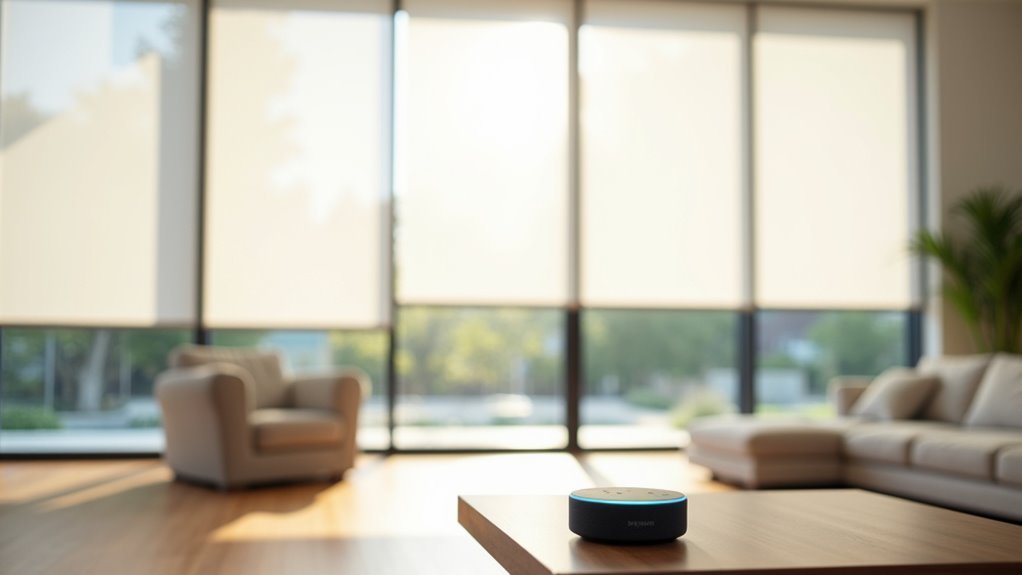
Versatility defines the SmartWings Motorized Light Filtering Roller Shades, which pack impressive functionality into a $170 package.
You’ll find 15 distinct styles spanning from sheer to blackout options, ensuring perfect light control for any room. These shades seamlessly integrate with your smart home ecosystem through Thread wireless technology, though you’ll need a Matter-compatible hub for setup.
Once installed, you can control them via Amazon Alexa, Apple Home, Google Home, or Samsung SmartThings. The quiet operation won’t disturb your daily activities or sleep.
You’ll appreciate how they enhance privacy while boosting energy efficiency throughout your space. The straightforward setup process and reliable connectivity make these shades an excellent choice for homeowners seeking affordable automation without sacrificing quality or performance.
Lutron Serena Smart Roller Shades
When you demand the quietest operation and most premium construction, Lutron Serena Smart Roller Shades deliver unmatched sophistication at $350 and up.
These ultra-quiet motors operate discreetly in any room, making them perfect for bedrooms and offices.
You’ll need the Lutron Caséta Smart Hub for Wi-Fi connectivity, but it enables seamless integration with Amazon Alexa, Apple Home, Google Home, and Samsung SmartThings.
Voice commands through Amazon Alexa let you control your shades effortlessly.
With over 100 color and style options, Lutron Serena shades complement any décor while providing excellent light control and privacy.
The Lutron app makes scheduling and remote control simple, letting you automate your window treatments for maximum convenience and energy efficiency.
Lutron Serena Smart Wood Blinds
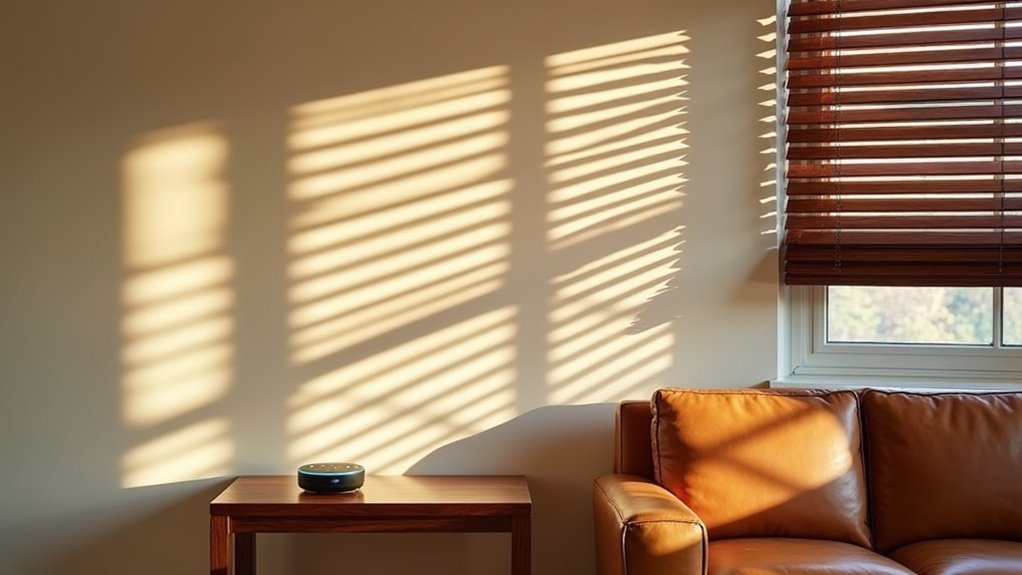
For those who prefer the classic elegance of wood, Lutron Serena Smart Wood Blinds offer the same premium technology with traditional styling starting at $700.
You’ll need a Lutron Caséta Smart Hub to connect this smart device to your Wi-Fi network and enable integration with your home automation system.
These blinds automatically adjust their louvers to optimize lighting and reduce glare, improving both comfort and energy efficiency.
You can control them through Amazon Alexa voice commands or other major platforms like Apple Home, Google Home, and Samsung SmartThings.
With over 100 color and style combinations available, you’ll find options that complement your interior design while delivering sophisticated smart functionality for your windows.
SmartWings Motorized Drapery
Budget-conscious homeowners can achieve premium automation with SmartWings Motorized Drapery at just $379. These smart home shades deliver quiet, reliable performance that works even with spotty Wi-Fi connections. You’ll enjoy seamless voice control through Amazon Alexa, Apple Home, Google Home, and Samsung SmartThings integration.
| Feature | Options | Benefits |
|---|---|---|
| Fabric Styles | 4 blackout, 5 sheer | Customizable light control |
| Power Options | Hardwired or plug-in | Flexible installation |
| Connectivity | Major smart platforms | Universal compatibility |
| Operation | Quiet motor system | Unobtrusive automation |
These motorized window treatments offer extended power cable options for versatile placement. You can customize your setup with various blackout and sheer textures to match your décor while maintaining functional light management throughout your automated home.
Setting Up Voice Commands for Your Smart Blinds
Once you’ve installed your smart blinds, configuring voice commands transforms your window treatments into truly hands-free automation.
First, verify your blinds are compatible with Amazon Alexa and connected to a smart hub. Then enable integration through your smart blinds’ dedicated app, linking accounts for seamless functionality.
Ensure your smart blinds work with Alexa and connect through your device’s app for smooth voice control integration.
Here’s how to optimize your voice commands:
- Create groups in the Alexa app for your window treatments, allowing commands like “Turn On [group name]” to control multiple blinds simultaneously.
- Customize phrases such as “Open [shade name]” or “Activate [scene name]” for specific treatments.
- Check regularly for Alexa app updates and new features related to your smart blinds.
This setup guarantees effortless control of your window treatments through simple voice commands.
Required Smart Home Hubs for Alexa Integration
You’ll need a compatible smart home hub to bridge the communication between your smart blinds and Alexa devices.
The setup process varies depending on your chosen hub, but most require linking through the Alexa app and ensuring your blinds work with that specific hub’s protocol.
Let’s explore which hubs work best and what you’ll need for a successful installation.
Hub Compatibility Overview
While Amazon Alexa can control various motorized blinds through voice commands, you’ll need a compatible smart home hub to bridge the connection between your blinds and Alexa ecosystem.
The smart hub acts as the translator between your blinds and Amazon Alexa, guaranteeing seamless communication and reliable voice control.
Here are three main hub compatibility options:
- Lutron Caséta Smart Hub – Required for Lutron Serena series blinds and provides dedicated functionality
- Matter-compatible hubs – Support newer SmartWings models and other Matter-enabled blinds
- Proprietary manufacturer hubs – Specific to certain blind brands and required for their ecosystems
You’ll also need to verify your smart hub and Alexa device maintain stable internet connections.
During setup, enable necessary integrations in your hub’s app and link your Amazon account for proper functionality.
Setup Requirements Guide
Setting up Alexa-compatible blinds requires specific hardware and software components working together. You’ll need a compatible smart home hub like the Lutron Caséta Smart Hub or Matter-compatible device to bridge your blinds with Amazon Alexa.
Before purchasing, verify your blinds appear on manufacturer compatibility lists to ascertain seamless integration.
Install and configure the PowerView App on your smartphone, then link it to your Amazon account for voice control functionality. Your internet connection must remain stable since both the PowerView Gateway and Alexa device depend on reliable connectivity to communicate with your window treatments.
Consider grouping multiple shades or rooms within the Alexa app. This smart home setup enhancement lets you control several window treatments simultaneously using single voice commands, maximizing convenience and efficiency.
Installation and Mounting Considerations
Before purchasing Alexa-compatible blinds, you’ll need to take precise measurements of your windows since most smart blinds require custom fitting. The installation process varies depending on your chosen model and mounting preference.
Consider these key installation factors:
- Mounting style – Choose between inside or outside mounting based on your window dimensions and aesthetic preferences.
- Power source – Battery-powered motorized blinds offer easier DIY installation, while hardwired options typically require professional assistance for safety compliance.
- Hardware quality – Look for brands like Serena Shades that include solid metal brackets and self-drilling screws to simplify the process.
Heavier models often benefit from professional installation due to drilling requirements.
However, many manufacturers provide clear instructions and mobile app controls for straightforward calibration, though some brands may require more tedious setup processes.
Measuring Your Windows for Custom Smart Blinds
You’ll need precise measurements to guarantee your custom Alexa-compatible blinds fit perfectly and function properly.
Start by deciding whether you want inside mount blinds that sit within the window frame or outside mount blinds that extend beyond it for better light control.
Use a metal tape measure and record all dimensions in inches, measuring width from inside edges for inside mounts or adding 1-3 inches beyond the frame for outside mounts.
Accurate Measurement Techniques
Precision makes the difference between smart blinds that fit flawlessly and ones that require costly returns or modifications.
When implementing accurate measurement techniques for your custom window, you’ll need a steel tape measure and systematic approach to confirm perfect results.
Follow these essential steps:
- Take three measurements for both width and height, using the smallest values when ordering.
- Subtract 1/4 inch from width for inside-mounted blinds to guarantee proper clearance.
- Add 2-4 inches to both dimensions for outside-mounted blinds to maximize light coverage.
Always measure from the top of your window casing for consistency.
Document everything clearly, noting your chosen mounting orientation and any unique features. This preparation confirms your Alexa-compatible blinds will install smoothly and operate perfectly.
Inside Vs Outside Mount
When choosing between inside and outside mount installations, you’ll dramatically impact both your smart blinds’ appearance and functionality.
Inside mount blinds fit within your window frame, creating a clean, streamlined look that’s perfect for modern homes. They sit flush with the window, providing an integrated appearance that doesn’t protrude into your room.
Outside mount blinds extend beyond the frame, making your windows appear larger while offering superior light control. You’ll cover more wall space around the window, eliminating light gaps that inside mounts might leave.
Consider your window’s depth and any obstructions like cranks or handles when deciding.
Inside mount requires sufficient depth, while outside mount gives you flexibility with placement on walls or ceilings, though it may need additional mounting hardware.
Battery Vs Hardwired Power Options
Two distinct power options define the smart blind landscape: battery-powered and hardwired systems. Your choice greatly impacts installation complexity, maintenance requirements, and long-term functionality.
Battery-powered smart blinds offer installation flexibility since you don’t need electrical outlet access. They typically require charging every 6-12 months under normal usage.
Battery-powered smart blinds provide DIY installation freedom without requiring nearby electrical outlets, though they need periodic charging every few months.
Models like SmartWings Motorized Drapery work well in areas with spotty Wi-Fi, making them versatile for any room location.
Hardwired smart blinds provide a permanent solution with consistent power supply, eliminating battery replacement concerns. However, they often require professional installation, especially when electrical work’s needed.
Consider these key factors:
- Installation ease – Battery models are generally DIY-friendly
- Maintenance – Hardwired eliminates charging schedules
- Advanced features – Hardwired options like Lutron Serena typically offer more robust smart home integrations
Creating Room Groups for Voice Control
Once you’ve established power for your smart blinds, maximizing their convenience through voice control becomes your next priority.
Creating room groups in the Alexa app streamlines your window treatment management considerably. Navigate to the Devices tab and select “Groups” to assign multiple blinds to single commands.
You’ll want to assign all rooms with window coverings to newly created groups, enabling commands like “Turn On Living Room Blinds” or “Turn Off Bedroom Shades.” This grouping approach enhances your home automation experience by allowing simultaneous control of multiple treatments.
Customize group names based on rooms or functions for intuitive voice interactions.
Remember to regularly check and update your group settings, ensuring all window treatments remain correctly included for efficient voice control execution.
Scheduling and Automation Features
Smart blinds truly shine when you set them to operate automatically throughout your day.
With robust scheduling capabilities, you can program your window treatments to align perfectly with your daily routine, eliminating the need for manual adjustments.
The automation features available with Alexa-compatible blinds offer three key advantages:
- Sunrise/sunset synchronization – Your blinds automatically adjust based on local daylight patterns for ideal energy efficiency.
- Custom time scheduling – Set specific opening and closing times that match your work schedule and privacy needs.
- Smart home integration – Sync your blinds with thermostats and lighting systems for thorough comfort management.
These scheduling options transform your home into a responsive environment that adapts to your lifestyle while maximizing both comfort and energy savings.
Troubleshooting Common Alexa Connectivity Issues
When your Alexa-compatible blinds aren’t responding properly, you’re likely dealing with one of three common issues that can disrupt your smart home experience.
Hub connection problems often occur when your PowerView Gateway loses its network connection, while voice command failures typically stem from miscommunication between Alexa and your blinds system.
Device recognition errors can also prevent Alexa from finding or controlling your window treatments, leaving you frustrated with unresponsive automation.
Hub Connection Problems
One of the most frustrating scenarios you’ll encounter involves your smart hub failing to maintain a stable connection with Alexa, leaving your blinds completely unresponsive to voice commands.
When your smart hub can’t communicate with Amazon Alexa, you’ll need to tackle the problem systematically.
Here’s your troubleshooting checklist:
- Verify internet connectivity – Ascertain your smart hub maintains a stable internet connection, as disruptions prevent Alexa communication.
- Check compatibility and skills – Confirm your hub works with Amazon Alexa and that you’ve enabled the necessary skills in the Alexa app.
- Update firmware – Install any available updates for both your smart hub and Alexa device to resolve connectivity issues.
If problems persist, re-link your smart hub through the respective app or reset it completely for a fresh start.
Voice Command Failures
Nothing proves more exasperating than issuing clear voice commands to Alexa only to have your blinds ignore every instruction.
Voice command failures typically stem from connectivity or configuration issues that you can resolve quickly.
First, confirm your PowerView Gateway is properly linked to your Amazon account through the Amazon Alexa app. Without successful account linking, voice commands won’t function.
Check the app’s “Devices” tab to verify your window treatments are grouped correctly with clear, recognizable names.
If Alexa still doesn’t respond, update the app and verify skill settings.
Often, voice command failures occur because devices aren’t named intuitively.
Try rephrasing commands using simpler language like “Turn On bedroom blinds” or “Turn Off living room shades” for better recognition and successful execution.
Device Recognition Errors
Beyond voice command failures, device recognition errors present another frustrating obstacle that prevents Alexa from detecting your smart blinds entirely.
When your blinds won’t appear in the Alexa ecosystem, you’ll lose both voice control and seamless app control functionality.
To resolve device recognition errors, follow these essential steps:
- Verify Hub Connectivity – Confirm your smart blinds connect to a compatible home automation hub that’s properly linked to your Amazon Alexa account for seamless integration.
- Update Firmware – Check for firmware updates on both your smart blinds and Alexa device, as outdated software commonly causes connectivity issues.
- Reset and Re-discover – Use the Amazon Alexa app to discover devices again, or reset your blinds completely and re-link them to clear underlying connectivity problems.
Frequently Asked Questions
What Blinds Can Alexa Control?
You can control motorized blinds from SmartWings, Lutron Serena, and OmniaBlinds with Alexa. You’ll need compatible smart hubs and must link them through the Alexa app for voice commands.
What Are the Best Smart Blinds for Home?
You’ll find SmartWings Motorized Light Filtering Roller Shades offer excellent value at $170, while Lutron Serena provides premium quality. For budget-friendly options, consider OmniaBlinds with 159 colors and customizable speeds.
Why Are Blinds Being Discontinued?
You’re seeing blinds discontinued because manufacturers are shifting toward smart, automated systems with voice control and eco-friendly materials. They’re also streamlining product lines due to changing consumer preferences and rising costs.
How to Get Alexa to Close Blinds?
You’ll need compatible smart blinds connected to a smart hub. Install the blinds’ skill in your Alexa app, then simply say “Alexa, close the living room blinds” for voice control.

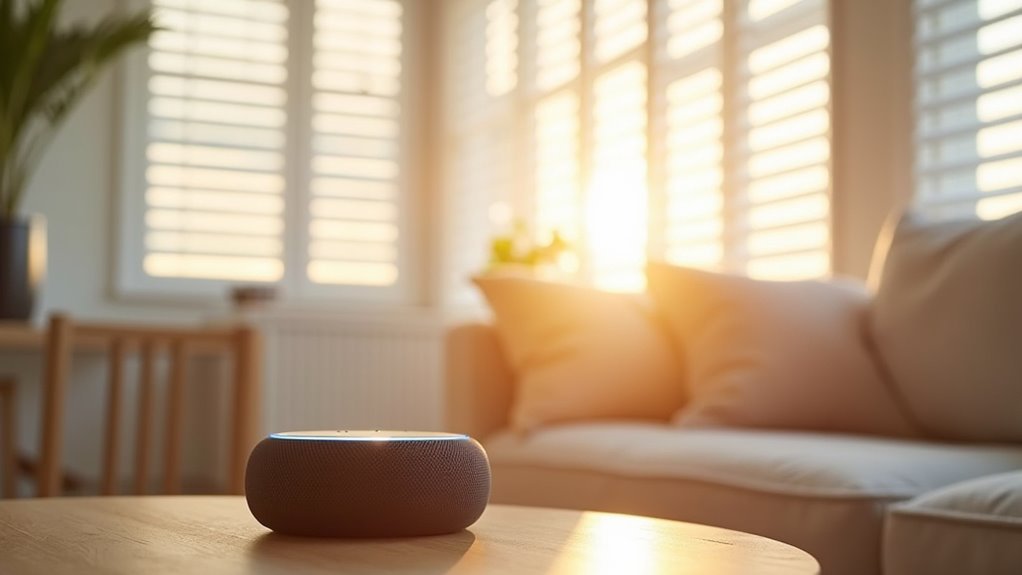
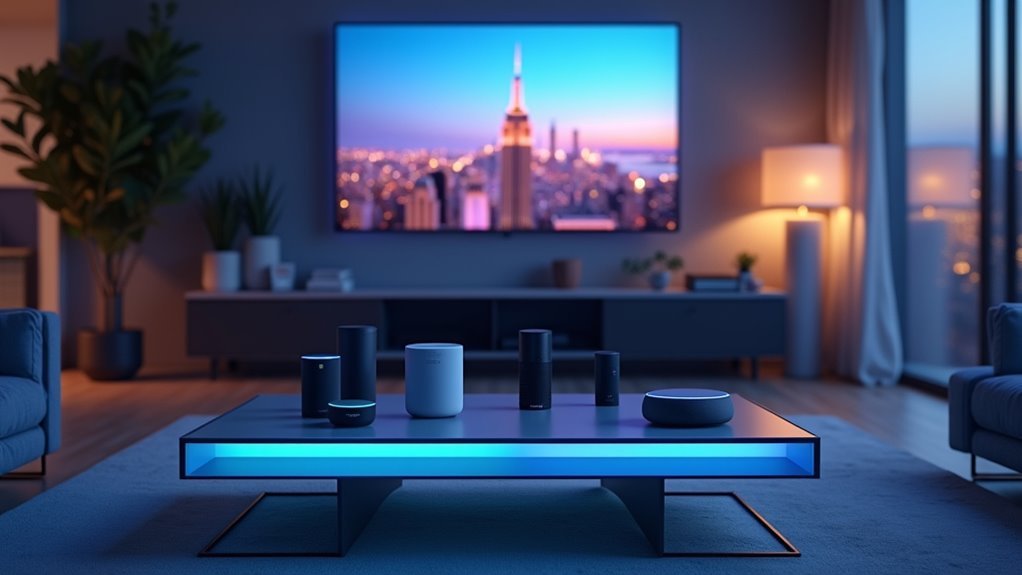
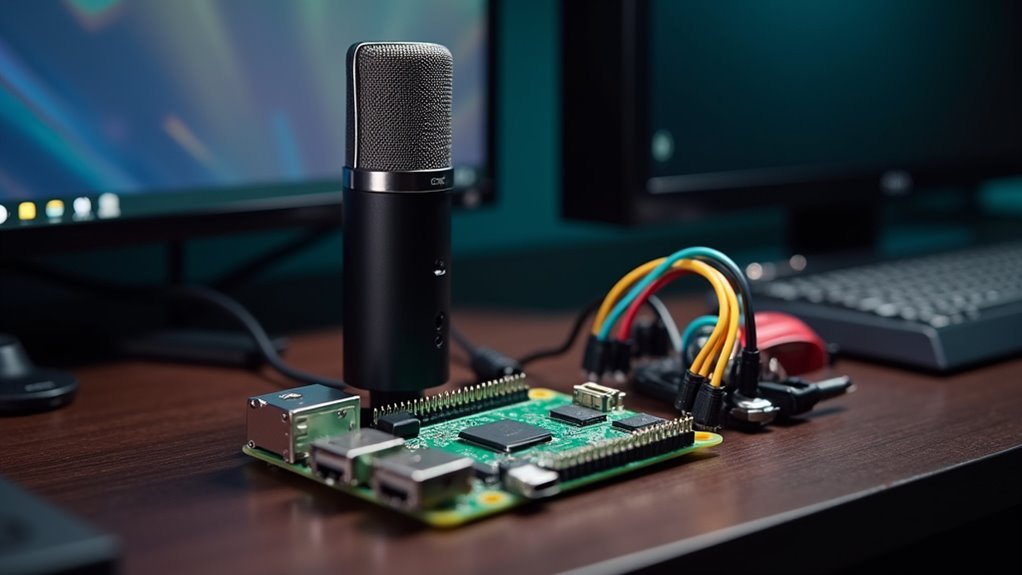

Leave a Reply